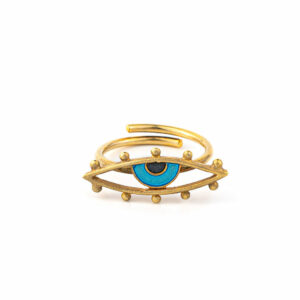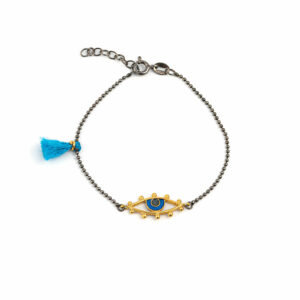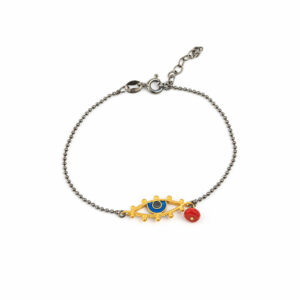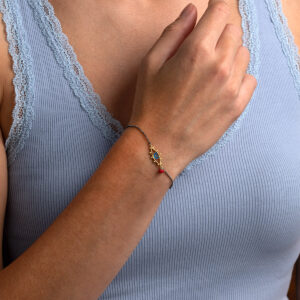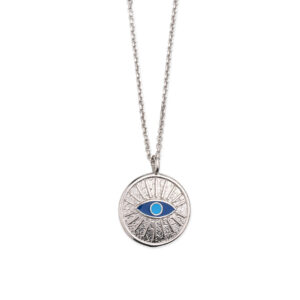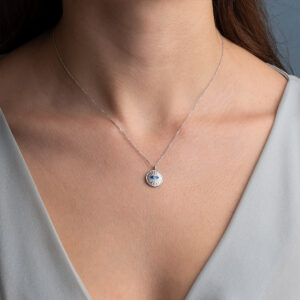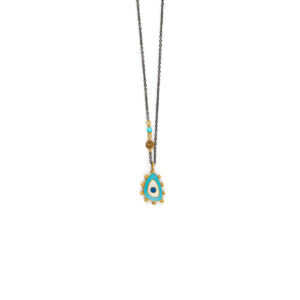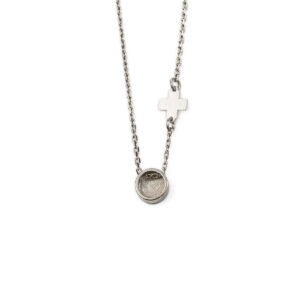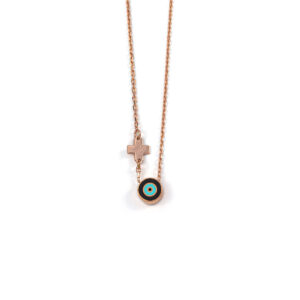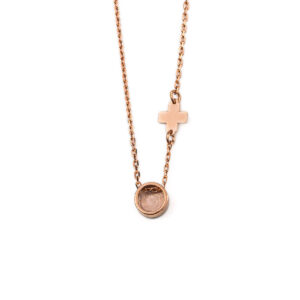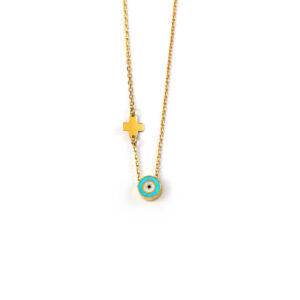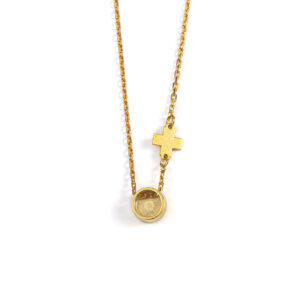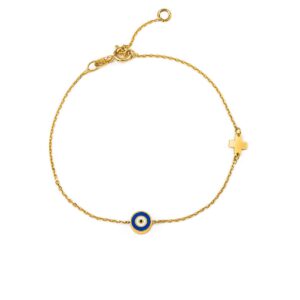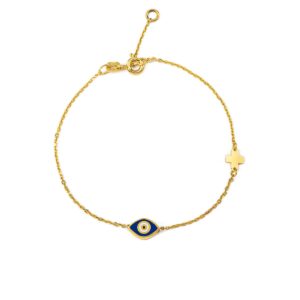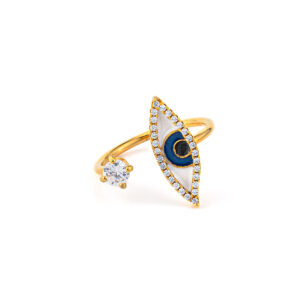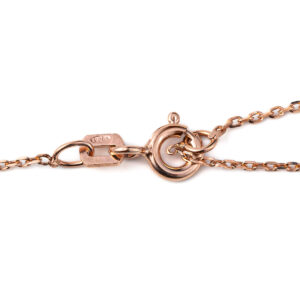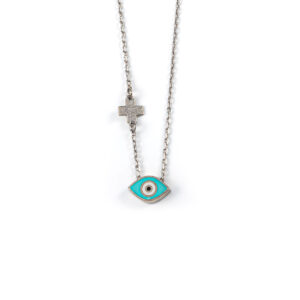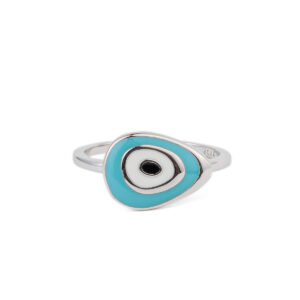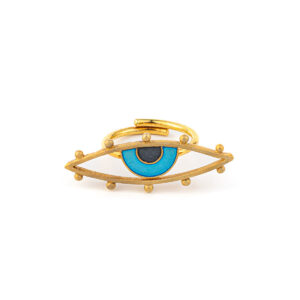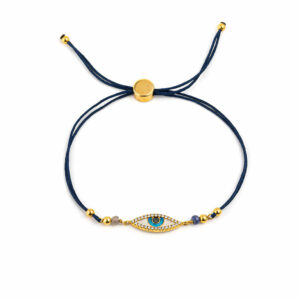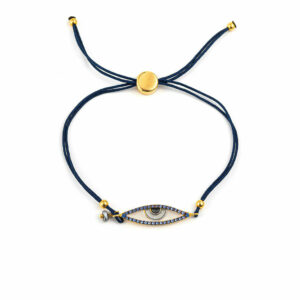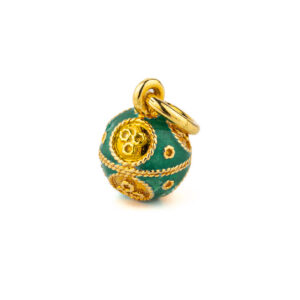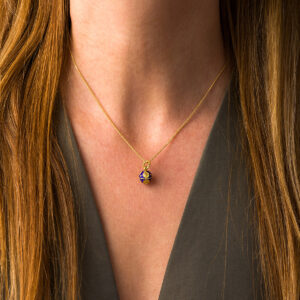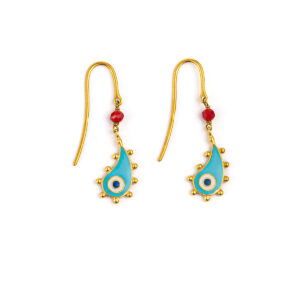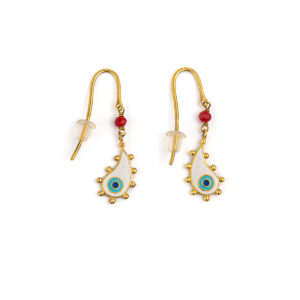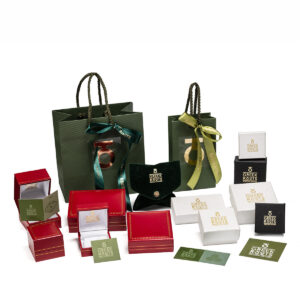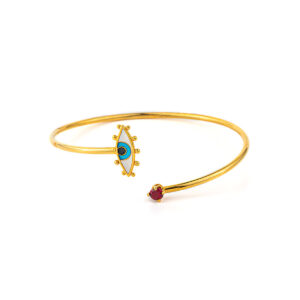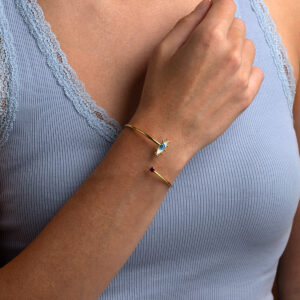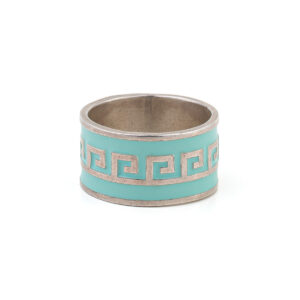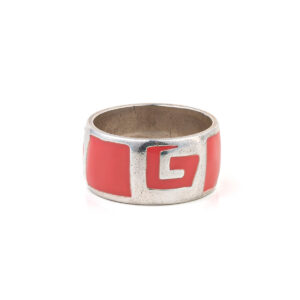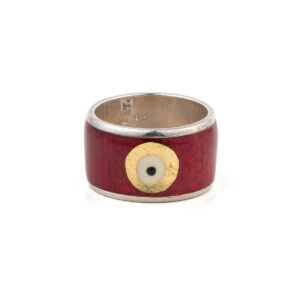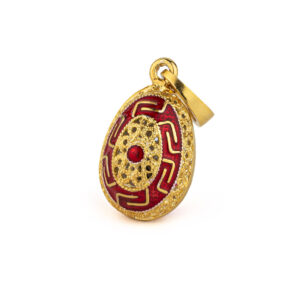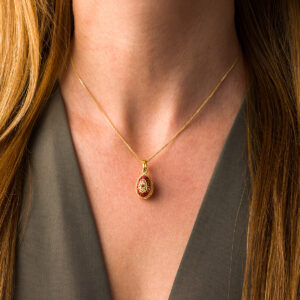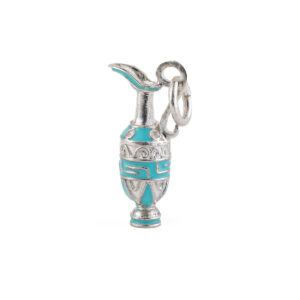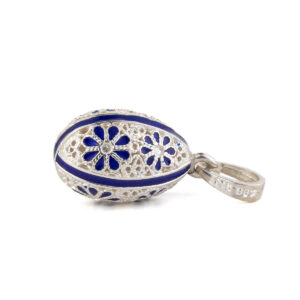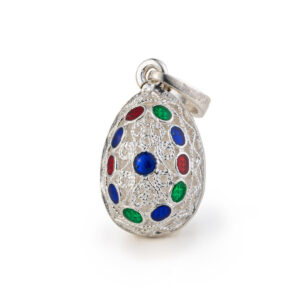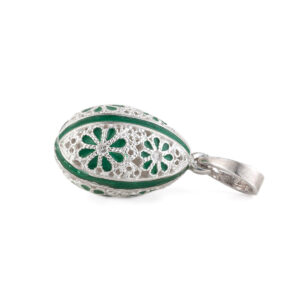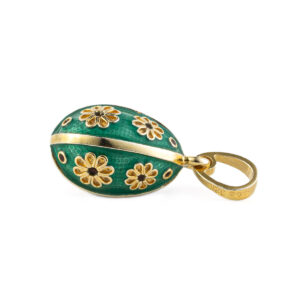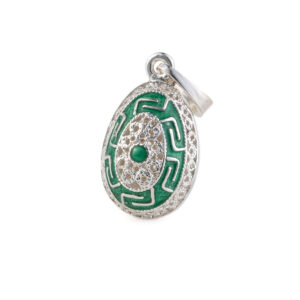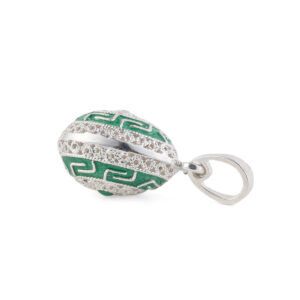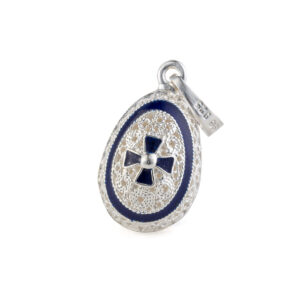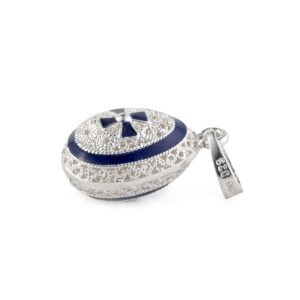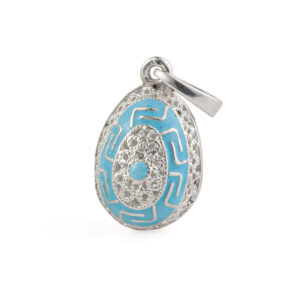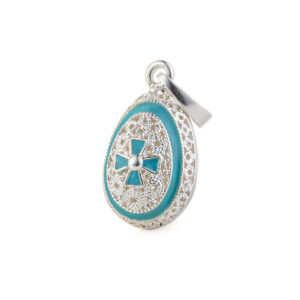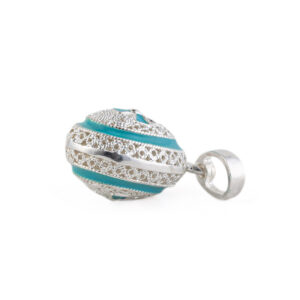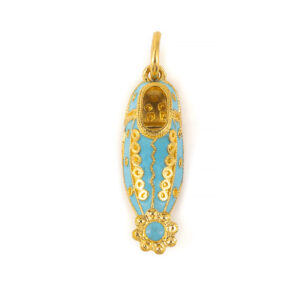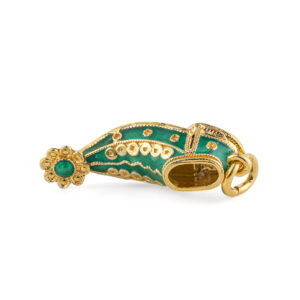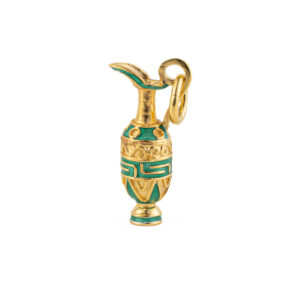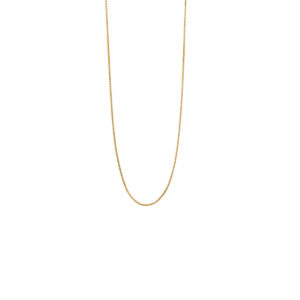Ασημένιο Δαχτυλίδι Μάτι Επίχρυσο με Σμάλτο
Δαχτυλίδι από ασήμι 925ο με μάτι διάτρητο με σμάλτο. Το δαχτυλίδι είναι ανοιχτό ώτε να μεταβάλλεται μερικώς το μέγεθος του. Η καθαρότητα του μετάλλου αναγράφεται στο κόσμημα με laser χάραξης.
Ασημένιο Βραχιόλι Μάτι με Σμάλτο
925 Βραχιόλι Ασημένιο Μάτι με Σμάλτο
Sterling Silver Plated Chain Necklace With Enamel Evil Eye
Made of 925⁰ sterling silver.
Handmade in Greece.
Explore Mati Collection
Evil Eye
The symbol and superstition of the evil eye is one of the strongest symbolic images in the world. The earliest known evidence for belief in the evil eye goes back to ancient Greece and Rome. It is supposed to wear off evil to anyone who wears it and various cultures believe in that, however in Greece, it’s blue because at that time blue eyes were not so common and were thought to give the evil eye, so the blue is like a mirror to them. Nowadays it’s widely known and has become a trend.
Κολιέ από ασημένια αλυσίδα με κρεμαστό μάτι με σμάλτο
Κολιέ Στρογγυλό Μάτι με Τυρκουάζ Σμάλτο και Σταυρό – Ασήμι 925
Κολιέ με Στρογγυλό Μάτι με τυρκουάζ σμάλτο και Σταυρό – Ασήμι 925
Κολιέ Ροζ Επιχρυσωμένο με Στρογγυλό Μάτι με μαύρο σμάλτο και Σταυρό – Ασήμι 925
Κολιέ Ροζ Επιχρυσωμένο με Στρογγυλό Μάτι με μαύρο σμάλτο και Σταυρό – Ασήμι 925
Κολιέ επιχρυσωμένο με Στρογγυλό Μάτι με τυρκουάζ σμάλτο και Σταυρό – Ασήμι 925 επιχρυσωμένο
Κολιέ επιχρυσωμένο με Στρογγυλό Μάτι με τυρκουάζ σμάλτο και Σταυρό – Ασήμι 925
Βραχιόλι Επιχρυσωμένο με Μάτι και Σταυρό με Μπλε Σμάλτο – Ασήμι 925
Βραχιόλι επιχρυσωμένο με Μάτι και Σταυρό με μπλέ σμάλτο – Ασήμι 925
Βραχιόλι Επιχρυσωμένο Μάτι με Μπλε Σμάλτο και Σταυρό – Ασήμι 925
Βραχιόλι επιχρυσωμένο Μάτι με μπλέ σμάλτο και Σταυρό – Ασήμι 925
Βραχιόλι Μάτι με Τυρκουάζ Σμάλτο και Σταυρό – Ασήμι 925
Βραχιόλι Μάτι με τυρκουάζ σμάλτο και Σταυρό – Ασήμι 925
Δαχτυλίδι με μάτι ασήμι 925 επιχρυσωμένο
Δαχτυλίδι από ασήμι 925ο επίχρυσο με μάτι διάτρητο με σμάλτο. Το δαχτυλίδι είναι ανοιχτό ώτε να μεταβάλλεται μερικώς το μέγεθος του. Η καθαρότητα του μετάλλου αναγράφεται στο κόσμημα με laser χάραξης.
Κολιέ Ροζ Επιχρυσωμένο Μάτι με Τυρκουάζ Σμάλτο και Σταυρό – Ασήμι
Κολιέ ροζ επιχρυσωμένο ασήμι 925, μάτι με τυρκουάζ σμάλτο και σταυρό.
Κολιέ Μάτι με Τυρκουάζ Σμάλτο και Σταυρό – Ασήμι 925
Κολιέ Μάτι με Τυρκουάζ σμάλτο και Σταυρό – Ασήμι 925
Δαχτυλίδι Μάτι διάτρητο με σμάλτο – ασήμι 925 επιχρυσωμένο
Δαχτυλίδι από ασήμι 925ο επίχρυσο με μάτι διάτρητο με σμάλτο. Το δαχτυλίδι είναι ανοιχτό ώτε να μεταβάλλεται μερικώς το μέγεθος του. Η καθαρότητα του μετάλλου αναγράφεται στο κόσμημα με laser χάραξης.
Μάτι Βραχιόλι από Ασήμι με πέτρες ζιργκόν
Βραχιόλι από σχοινάκι με ασημένιο 925ο/οο και επιμεταλλωμένο μάτι γεμάτο πέτρες και σμάλτο στο εσωτερικό, μπίλιες και πέτρα. Το ειδικό κούμπωμα βοηθάει στην προσαρμογή του μεγέθους.
Ασημένιο Μάτι Βραχιόλι επιχρυσωμένο με πέτρες ζιργκόν
Βραχιόλι Ασημένιο 925 Μάτι με Σμάλτο
Μενταγιόν Αυγό με Πράσινο Σμάλτο – Ασήμι 925 Επιχρυσωμένο
Κατασκευασμένο από επιχρυσωμένο ασήμι 925.
Το μενταγιόν είναι διακοσμημένο με λεπτό φιλιγκράν και πράσινο σμάλτο σε στυλ Faberge.
Περιλαμβάνεται η αλυσίδα που φαίνεται.
Χρησιμοποιείται ως γούρι ή ως μενταγιόν. Πάρτε ένα όμορφο δώρο εμπνευσμένο από τη μαγευτική τέχνη του Fabergé!
Χειροποίητο ελληνικό κόσμημα.
Μενταγιόν Αυγό με Τιρκουάζ Σμάλτο – Ασήμι 925 Επιχρυσωμένο
Κατασκευασμένο από επιχρυσωμένο ασήμι 925.
Το μενταγιόν είναι διακοσμημένο με λεπτό φιλιγκράν και τιρκουάζ σμάλτο σε στυλ Faberge.
Περιλαμβάνεται η αλυσίδα που φαίνεται.
Χρησιμοποιείται ως γούρι ή ως μενταγιόν. Πάρτε ένα όμορφο δώρο εμπνευσμένο από τη μαγευτική τέχνη του Fabergé!
Χειροποίητο ελληνικό κόσμημα.
Μενταγιόν Αυγό με Μπλε Σμάλτο – Ασήμι 925 Επιχρυσωμένο
Κατασκευασμένο από επιχρυσωμένο ασήμι 925.
Το μενταγιόν είναι διακοσμημένο με λεπτό φιλιγκράν και μπλε σμάλτο σε στυλ Faberge.
Περιλαμβάνεται η αλυσίδα που φαίνεται.
Χρησιμοποιείται ως γούρι ή ως μενταγιόν. Πάρτε ένα όμορφο δώρο εμπνευσμένο από τη μαγευτική τέχνη του Fabergé!
Χειροποίητο ελληνικό κόσμημα.
Ασημένια κρεμαστά σκουλαρίκια μάτι με σμάλτο
Ασημένια κρεμαστά επίχρυσα σκουλαρίκια μάτι με σμάλτο
Δαχτυλίδι Μαίανδρος Μπλε Σμάλτο – Ασήμι 925
Δαχτυλίδι εμπνευσμένο από το ελληνικό σύμβολο του μαιάνδρου.
Κατασκευασμένο από ασήμι 925°.
Χειροποίητο Ελληνικό Κόσμημα.
Ανακαλύψτε τη Συλλογή Μαίανδρος
Ιστορία
Το σχέδιο Μαιάνδρου είναι ένα διακοσμητικό περίγραμμα που δημιουργείται από μια συνεχή γραμμή, η οποία σχηματίζεται σε ένα επαναλαμβανόμενο μοτίβο. Ένα τέτοιο σχέδιο ονομάζεται επίσης ελληνικός κροσσός ή ελληνικό σχέδιο κλειδιού, αν και πρόκειται για σύγχρονες ονομασίες. Από τη μία πλευρά, η ονομασία “μαίανδρος” θυμίζει τη στροφική πορεία του ποταμού Μαιάνδρου στη Μικρά Ασία, και από την άλλη πλευρά, όπως επεσήμανε ο Karl Kerenyi, “ο μαίανδρος είναι το σχήμα ενός λαβύρινθου σε γραμμική μορφή” το νόημα είναι ότι δεν υπάρχει αρχή και τέλος σε ορισμένες περιπτώσεις έτσι γίνεται το σύμβολο της μακράς ζωής και της αιωνιότητας.
Βραχιόλι επιχρυσωμένο ασήμι 925 μάτι με σμάλτο
Βραχιόλι από ασήμι επιχρυσωμένο με ματάκι με σμάλτο στη μία άκρη και πέτρα στη άλλη.
Στρογγυλά Πολύχρωμα Καρφωτά Σκουλαρίκια – Ασήμι 925
Κατασκευασμένα από ασήμι 925°.
Χειροποίητο ελληνικό κόσμημα.
Ανακαλύψτε περισσότερες Προσφορές
Δαχτυλίδι Μαίανδρος Τυρκουάζ Σμάλτο – Ασήμι 925
Δαχτυλίδι εμπνευσμένο από το ελληνικό σύμβολο του μαιάνδρου.
Κατασκευασμένο από ασήμι 925°.
Χειροποίητο ελληνικό κόσμημα.
Ανακαλύψτε τη Συλλογή Μαίανδρος
Ιστορία
Το σχέδιο Μαιάνδρου είναι ένα διακοσμητικό περίγραμμα που δημιουργείται από μια συνεχή γραμμή, η οποία σχηματίζεται σε ένα επαναλαμβανόμενο μοτίβο. Ένα τέτοιο σχέδιο ονομάζεται επίσης ελληνικός κροσσός ή ελληνικό σχέδιο κλειδιού, αν και πρόκειται για σύγχρονες ονομασίες. Από τη μία πλευρά, η ονομασία “μαίανδρος” θυμίζει τη στροφική πορεία του ποταμού Μαιάνδρου στη Μικρά Ασία, και από την άλλη πλευρά, όπως επεσήμανε ο Karl Kerenyi, “ο μαίανδρος είναι το σχήμα ενός λαβύρινθου σε γραμμική μορφή” το νόημα είναι ότι δεν υπάρχει αρχή και τέλος σε ορισμένες περιπτώσεις έτσι γίνεται το σύμβολο της μακράς ζωής και της αιωνιότητας.
Δαχτυλίδι Μαίανδρος Ροζ Σμάλτο – Ασήμι 925
Δαχτυλίδι εμπνευσμένο από το ελληνικό σύμβολο του μαιάνδρου.
Χειροποίητο Ελληνικό Κόσμημα.
Ανακαλύψτε τη Συλλογή Μαίανδρος
Ιστορία
Το σχέδιο Μαιάνδρου είναι ένα διακοσμητικό περίγραμμα που δημιουργείται από μια συνεχή γραμμή, η οποία σχηματίζεται σε ένα επαναλαμβανόμενο μοτίβο. Ένα τέτοιο σχέδιο ονομάζεται επίσης ελληνικός κροσσός ή ελληνικό σχέδιο κλειδιού, αν και πρόκειται για σύγχρονες ονομασίες. Από τη μία πλευρά, η ονομασία “μαίανδρος” θυμίζει τη στροφική πορεία του ποταμού Μαιάνδρου στη Μικρά Ασία, και από την άλλη πλευρά, όπως επεσήμανε ο Karl Kerenyi, “ο μαίανδρος είναι το σχήμα ενός λαβύρινθου σε γραμμική μορφή” το νόημα είναι ότι δεν υπάρχει αρχή και τέλος σε ορισμένες περιπτώσεις έτσι γίνεται το σύμβολο της μακράς ζωής και της αιωνιότητας.
Δαχτυλίδι Σπείρα με Σμάλτο και Φύλλα Χρυσού – Ασήμι 925
Χειροποίητο κόσμημα, φτιαγμένο από ασήμι 925.
Δαχτυλίδι Μάτι Κόκκινο Σμάλτο – Ασήμι 925
Κατασκευασμένο από ασήμι 925°.
Χειροποίητο Ελληνικό Κόσμημα.
Ανακαλύψτε τη συλλογή Μάτι
Μάτι
Το σύμβολο και η δεισιδαιμονία του κακού ματιού είναι μια από τις ισχυρότερες συμβολικές εικόνες στον κόσμο. Τα πρώτα γνωστά στοιχεία για την πίστη στο κακό μάτι ανάγονται στην αρχαία Ελλάδα και τη Ρώμη. Υποτίθεται ότι αποβάλλει το κακό σε όποιον το φοράει και διάφοροι πολιτισμοί πιστεύουν σε αυτό, ωστόσο στην Ελλάδα είναι μπλε γιατί εκείνη την εποχή τα μπλε μάτια δεν ήταν τόσο συνηθισμένα και θεωρούσαν ότι έδιναν το κακό μάτι, οπότε το μπλε είναι σαν καθρέφτης για αυτούς. Σήμερα είναι ευρέως γνωστό και έχει γίνει μόδα.
Κολιέ Μενταγιόν Αυγό με Κόκκινο Μαίανδρο – Ασήμι 925 Επιχρυσωμένο
Κατασκευασμένο από επιχρυσωμένο ασήμι 925.
Το μενταγιόν είναι διακοσμημένο με λεπτό φιλιγκράν και κόκκινο σμάλτο σε στυλ Faberge.
Περιλαμβάνεται η αλυσίδα που φαίνεται.
Χρησιμοποιείται ως γούρι ή ως μενταγιόν. Πάρτε ένα όμορφο δώρο εμπνευσμένο από τη μαγευτική τέχνη του Fabergé!
Χειροποίητο ελληνικό κόσμημα.
Μενταγιόν Αυγό με Τιρκουάζ Μαίανδρο – Ασήμι 925 Επιχρυσωμένο
Κατασκευασμένο από επιχρυσωμένο ασήμι 925.
Το μενταγιόν είναι διακοσμημένο με λεπτό φιλιγκράν και τιρκουάζ σμάλτο σε στυλ Faberge.
Περιλαμβάνεται η αλυσίδα που φαίνεται.
Χρησιμοποιείται ως γούρι ή ως μενταγιόν. Πάρτε ένα όμορφο δώρο εμπνευσμένο από τη μαγευτική τέχνη του Fabergé!
Χειροποίητο ελληνικό κόσμημα.
Μενταγιόν Αυγό – Ασήμι 925 Επιχρυσωμένο
99,00€ – 119,00€Κατασκευασμένο από επιχρυσωμένο ασήμι 925.
Το μενταγιόν είναι διακοσμημένο με λεπτό φιλιγκράν σε στυλ Faberge.
Περιλαμβάνεται η αλυσίδα που φαίνεται.
Χρησιμοποιείται ως γούρι ή ως μενταγιόν. Πάρτε ένα όμορφο δώρο εμπνευσμένο από τη μαγευτική τέχνη του Fabergé!
Χειροποίητο ελληνικό κόσμημα.
Κολιέ με Μενταγιόν Αμφορέας Μπλε – Ασήμι 925
Κατασκευασμένο από ασήμι 925⁰ και σμάλτο.
Χειροποίητο Eλληνικό Kόσμημα.
Κολιέ με Μενταγιόν Αυγό – Ασήμι 925
The pendant is embellished with a fine filigree and blue enamel in Faberge style.
Made of 925 sterling silver.
Handmade in Greece.
The chain shown is included.
Filigree is a delicate kind of jewellery metalwork, made with tiny beads or twisted threads, or both in combination, soldered together or to the surface of an object of the same metal and arranged in artistic motifs. The art of filigree dates back to ancient history. The first of the found jewelry in this technique have been found in Mesopotamia and dates to thousands of years BC. In the ancient world and particularly in Asia Minor, this art grew were at the highest level.
Fabergé egg is a jeweled egg created by the House of Fabergé, in St. Petersburg, Imperial Russia. Virtually all were manufactured under the supervision of Peter Carl Fabergé between 1885 and 1917,[citation needed] the most famous being the 50 “Imperial” eggs, 43 of which survive, made for the Russian Tsars Alexander III and Nicholas II as Easter gifts for their wives and mothers. The first Fabergé egg was crafted for Tsar Alexander III, who had decided to give his wife, the Empress Maria Feodorovna, an Easter egg in 1885. Peter Carl Fabergé was a Russian jeweller best known for the famous Fabergé eggs made in the style of genuine Easter eggs, using precious metals and gemstones. He’s the founder of the famous jewelry legacy House of Fabergé.
Κολιέ με Μενταγιόν Αυγό – Ασήμι 925
The pendant is embellished with a fine filigree and multicolor enamel in Faberge style.
Made of 925 sterling silver.
Handmade in Greece.
The chain shown is included.
Filigree is a delicate kind of jewellery metalwork, made with tiny beads or twisted threads, or both in combination, soldered together or to the surface of an object of the same metal and arranged in artistic motifs. The art of filigree dates back to ancient history. The first of the found jewelry in this technique have been found in Mesopotamia and dates to thousands of years BC. In the ancient world and particularly in Asia Minor, this art grew were at the highest level.
Fabergé egg is a jeweled egg created by the House of Fabergé, in St. Petersburg, Imperial Russia. Virtually all were manufactured under the supervision of Peter Carl Fabergé between 1885 and 1917,[citation needed] the most famous being the 50 “Imperial” eggs, 43 of which survive, made for the Russian Tsars Alexander III and Nicholas II as Easter gifts for their wives and mothers. The first Fabergé egg was crafted for Tsar Alexander III, who had decided to give his wife, the Empress Maria Feodorovna, an Easter egg in 1885. Peter Carl Fabergé was a Russian jeweller best known for the famous Fabergé eggs made in the style of genuine Easter eggs, using precious metals and gemstones. He’s the founder of the famous jewelry legacy House of Fabergé.
Κολιέ με Μενταγιόν Αυγό – Ασήμι 925
The pendant is embellished with a fine filigree and enamel in Faberge style.
Made of 925 sterling silver.
Handmade in Greece.
The chain shown is included.
Filigree is a delicate kind of jewellery metalwork, made with tiny beads or twisted threads, or both in combination, soldered together or to the surface of an object of the same metal and arranged in artistic motifs. The art of filigree dates back to ancient history. The first of the found jewelry in this technique have been found in Mesopotamia and dates to thousands of years BC. In the ancient world and particularly in Asia Minor, this art grew were at the highest level.
Fabergé egg is a jeweled egg created by the House of Fabergé, in St. Petersburg, Imperial Russia. Virtually all were manufactured under the supervision of Peter Carl Fabergé between 1885 and 1917,[citation needed] the most famous being the 50 “Imperial” eggs, 43 of which survive, made for the Russian Tsars Alexander III and Nicholas II as Easter gifts for their wives and mothers. The first Fabergé egg was crafted for Tsar Alexander III, who had decided to give his wife, the Empress Maria Feodorovna, an Easter egg in 1885. Peter Carl Fabergé was a Russian jeweller best known for the famous Fabergé eggs made in the style of genuine Easter eggs, using precious metals and gemstones. He’s the founder of the famous jewelry legacy House of Fabergé.
Κολιέ με Μενταγιόν Αυγό – Ασήμι 925 Επιχρυσωμένο
The pendant is embellished with a fine filigree and enamel in Faberge style.
Made of 925 sterling silver and gold plated.
Handmade in Greece.
The chain shown is included.
Filigree is a delicate kind of jewellery metalwork, made with tiny beads or twisted threads, or both in combination, soldered together or to the surface of an object of the same metal and arranged in artistic motifs. The art of filigree dates back to ancient history. The first of the found jewelry in this technique have been found in Mesopotamia and dates to thousands of years BC. In the ancient world and particularly in Asia Minor, this art grew were at the highest level.
Fabergé egg is a jeweled egg created by the House of Fabergé, in St. Petersburg, Imperial Russia. Virtually all were manufactured under the supervision of Peter Carl Fabergé between 1885 and 1917,[citation needed] the most famous being the 50 “Imperial” eggs, 43 of which survive, made for the Russian Tsars Alexander III and Nicholas II as Easter gifts for their wives and mothers. The first Fabergé egg was crafted for Tsar Alexander III, who had decided to give his wife, the Empress Maria Feodorovna, an Easter egg in 1885. Peter Carl Fabergé was a Russian jeweller best known for the famous Fabergé eggs made in the style of genuine Easter eggs, using precious metals and gemstones. He’s the founder of the famous jewelry legacy House of Fabergé.
Κολιέ με Μενταγιόν Αυγό – Ασήμι 925
The pendant is embellished with a fine filigree and enamel in Faberge style.
Made of 925 sterling silver.
Handmade in Greece.
The chain shown is included.
Filigree is a delicate kind of jewellery metalwork, made with tiny beads or twisted threads, or both in combination, soldered together or to the surface of an object of the same metal and arranged in artistic motifs. The art of filigree dates back to ancient history. The first of the found jewelry in this technique have been found in Mesopotamia and dates to thousands of years BC. In the ancient world and particularly in Asia Minor, this art grew were at the highest level.
Fabergé egg is a jeweled egg created by the House of Fabergé, in St. Petersburg, Imperial Russia. Virtually all were manufactured under the supervision of Peter Carl Fabergé between 1885 and 1917,[citation needed] the most famous being the 50 “Imperial” eggs, 43 of which survive, made for the Russian Tsars Alexander III and Nicholas II as Easter gifts for their wives and mothers. The first Fabergé egg was crafted for Tsar Alexander III, who had decided to give his wife, the Empress Maria Feodorovna, an Easter egg in 1885. Peter Carl Fabergé was a Russian jeweller best known for the famous Fabergé eggs made in the style of genuine Easter eggs, using precious metals and gemstones. He’s the founder of the famous jewelry legacy House of Fabergé.
Κολιέ με Μενταγιόν Αυγό – Ασήμι 925
The pendant is embellished with a fine filigree and enamel in Faberge style.
Made of 925 sterling silver.
Handmade in Greece.
The chain shown is included.
Filigree is a delicate kind of jewellery metalwork, made with tiny beads or twisted threads, or both in combination, soldered together or to the surface of an object of the same metal and arranged in artistic motifs. The art of filigree dates back to ancient history. The first of the found jewelry in this technique have been found in Mesopotamia and dates to thousands of years BC. In the ancient world and particularly in Asia Minor, this art grew were at the highest level.
Fabergé egg is a jeweled egg created by the House of Fabergé, in St. Petersburg, Imperial Russia. Virtually all were manufactured under the supervision of Peter Carl Fabergé between 1885 and 1917,[citation needed] the most famous being the 50 “Imperial” eggs, 43 of which survive, made for the Russian Tsars Alexander III and Nicholas II as Easter gifts for their wives and mothers. The first Fabergé egg was crafted for Tsar Alexander III, who had decided to give his wife, the Empress Maria Feodorovna, an Easter egg in 1885. Peter Carl Fabergé was a Russian jeweller best known for the famous Fabergé eggs made in the style of genuine Easter eggs, using precious metals and gemstones. He’s the founder of the famous jewelry legacy House of Fabergé.
Κολιέ με Μενταγιόν Αυγό – Ασήμι 925
The pendant is embellished with a fine filigree and enamel in Faberge style.
Made of 925 sterling silver.
Handmade in Greece.
The chain shown is included.
Filigree is a delicate kind of jewellery metalwork, made with tiny beads or twisted threads, or both in combination, soldered together or to the surface of an object of the same metal and arranged in artistic motifs. The art of filigree dates back to ancient history. The first of the found jewelry in this technique have been found in Mesopotamia and dates to thousands of years BC. In the ancient world and particularly in Asia Minor, this art grew were at the highest level.
Fabergé egg is a jeweled egg created by the House of Fabergé, in St. Petersburg, Imperial Russia. Virtually all were manufactured under the supervision of Peter Carl Fabergé between 1885 and 1917,[citation needed] the most famous being the 50 “Imperial” eggs, 43 of which survive, made for the Russian Tsars Alexander III and Nicholas II as Easter gifts for their wives and mothers. The first Fabergé egg was crafted for Tsar Alexander III, who had decided to give his wife, the Empress Maria Feodorovna, an Easter egg in 1885. Peter Carl Fabergé was a Russian jeweller best known for the famous Fabergé eggs made in the style of genuine Easter eggs, using precious metals and gemstones. He’s the founder of the famous jewelry legacy House of Fabergé.
Κολιέ με Μενταγιόν Αυγό – Ασήμι 925
The pendant is embellished with a fine filigree and enamel in Faberge style.
Made of 925 sterling silver.
Handmade in Greece.
The chain shown is included.
Filigree is a delicate kind of jewellery metalwork, made with tiny beads or twisted threads, or both in combination, soldered together or to the surface of an object of the same metal and arranged in artistic motifs. The art of filigree dates back to ancient history. The first of the found jewelry in this technique have been found in Mesopotamia and dates to thousands of years BC. In the ancient world and particularly in Asia Minor, this art grew were at the highest level.
Fabergé egg is a jeweled egg created by the House of Fabergé, in St. Petersburg, Imperial Russia. Virtually all were manufactured under the supervision of Peter Carl Fabergé between 1885 and 1917,[citation needed] the most famous being the 50 “Imperial” eggs, 43 of which survive, made for the Russian Tsars Alexander III and Nicholas II as Easter gifts for their wives and mothers. The first Fabergé egg was crafted for Tsar Alexander III, who had decided to give his wife, the Empress Maria Feodorovna, an Easter egg in 1885. Peter Carl Fabergé was a Russian jeweller best known for the famous Fabergé eggs made in the style of genuine Easter eggs, using precious metals and gemstones. He’s the founder of the famous jewelry legacy House of Fabergé.
Κολιέ με Μενταγιόν Τσαρούχι – Ασήμι 925 Επιχρυσωμένο
Have you witnessed the changing of the guards in Syntagma square? This is the most traditional shoe of Greece (tsarouhi). The pendant is decorated with green enamel and rosette motif.
The rosette (rose) is a timeless jewel, symbol and amulet. The origin of the term is the Greek word for rose – rodon (ρόδον). Its use began in the Mycenaean era and continues as far as the 2nd millennia BC. The Mycenaean Rosette is a motif that was widespread throughout Mesopotamia, Egypt, Greece and other ancient civilizations. Rosette or Rodax was probably the most popular and favorite decorative element in Mycenaean era, classical antiquity and Byzantine times.
Made of sterling silver and gold plated.
Handmade item.
Design inspired by the Greek tradition
Κολιέ με Μενταγιόν Τσαρούχι – Ασήμι 925 Επιχρυσωμένο
Have you witnessed the changing of the guards in Syntagma square? This is the most traditional shoe of Greece (tsarouhi). The pendant is decorated with green enamel and rosette motif.
The rosette (rose) is a timeless jewel, symbol and amulet. The origin of the term is the Greek word for rose – rodon (ρόδον). Its use began in the Mycenaean era and continues as far as the 2nd millennia BC. The Mycenaean Rosette is a motif that was widespread throughout Mesopotamia, Egypt, Greece and other ancient civilizations. Rosette or Rodax was probably the most popular and favorite decorative element in Mycenaean era, classical antiquity and Byzantine times.
Made of sterling silver and gold plated.
Handmade item.
Design inspired by the Greek tradition
Κολιέ με Μενταγιόν Τσαρούχι – Ασήμι 925 Επιχρυσωμένο
Have you witnessed the changing of the guards in Syntagma square? This is the most traditional shoe of Greece (tsarouhi). The pendant is decorated with green enamel and rosette motif.
The rosette (rose) is a timeless jewel, symbol and amulet. The origin of the term is the Greek word for rose – rodon (ρόδον). Its use began in the Mycenaean era and continues as far as the 2nd millennia BC. The Mycenaean Rosette is a motif that was widespread throughout Mesopotamia, Egypt, Greece and other ancient civilizations. Rosette or Rodax was probably the most popular and favorite decorative element in Mycenaean era, classical antiquity and Byzantine times.
Made of sterling silver and gold plated.
Handmade item.
Design inspired by the Greek tradition
Κολιέ με Μενταγιόν Αμφορέας – Ασήμι 925 Επιχρυσωμένο
Ancient Greek Amphora Pendant with enamel.
Design inspired by the ancient Greek history.
Made of sterling silver and gold plated.
Handmade item
Amphora is a Greco – Roman word developed in ancient Greek during the Bronze Age. An amphora is a type of container of a characteristic shape and size. Amphorae were used for the transport and storage of various products, both liquid and dry, but mostly for wine. They are most often ceramic. the amphorae used in Ancient Greek vase painting. (source wikipedia)

